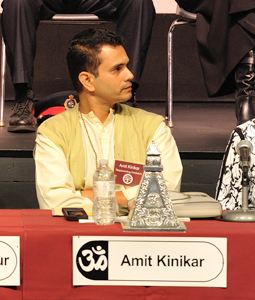Questions Responded by Amit M. Kinikar
Ordained Minister of the Vedanta
Representing Hinduism
Question 1: Do you believe that a society should be governed by a caste system? Or do you approve of caste system according to Hinduism?
The much-talked-of caste system is based on the three mental temperaments of a human being-sattva, rajas, and tamas. Sattva is the state of thoughts in equanimity, serenity, objectivity. Rajas is the state of passionate, desirous and agitated thoughts. Tamas is the state of thoughts in inertia. A mood of lethargy, indolence, indifference.
Every human being is made up of these three mental temperaments. But the proportion varies from individual to individual. It is this difference in the proportion which creates the four categories of people in the world:
- Brahmana-priest-class/thinkers
- Kshatriya-Warrior-class/leaders
- Vaishya-Trader-class
- Shudra- Labour-class
This classification naturally exists in any society. It is based on one’s inner nature and not on birth into a particular family. For example, a Brahmana ( you can use any other name) is predominantly sattvic and designed to study and preach, do research or thinking job, due to his inherent serene nature. Now such a person is a Brahmin even if he is born in the family of a labour.
But the caste system, as it is misunderstood and practiced today, has no meaning.
Question 2 : Why cow is sacred to Hindu?
Hindus respect all animals and not only cow in particular. Cow worship has got symbolic significance.
Cow gives wholesome milk to the society. Milk is a universal food consumed by one and all. She gives something valuable to the society and takes hardly anything in return. The cow-worshippers are supposed to imbibe this great quality, the attitude of ‘giving’ into their own lives. If the attitude of ‘taking’ prevails in a society its members develop selfish demands and desires. Consequently there is struggle, stress and strain in that society.
Let that attitude change to giving, their demands and desires drop their selfishness. Harmony, peace and happiness reign in that very same society.
Thus, the cow per se is worshipped but the principle of “ Maximum work minimum profit” on which she seems to function.
Question 3: Is the God of a particular faith or religion the same God of other religions ? Is it one and the same God that revealed different scriptures?
There is only one God, Truth, or Divinity, referred to as Brahman, Father in Heaven etc.
Every human being has a potential to reach that state of Godhood and a person who has reached that state is called as a God-realised or an Enlightened person. Different people at different periods of time in the history have reached that state and all of them have declared the same thing-‘You are that Truth’.
One can reach that ultimate state of God-realization by annihilating all the desires. Human being minus desires equals Truth or Divinity. Therefore desires have been personified as something negative in all the religions. In Christianity as Satan, in Islam as Shaitan, in Buddhism as Mara and in Hinduism as Asura. Three traditional paths; path of action, devotion and knowledge, remove the encrustation of desires. When desires are reduced considerably one develops mental concentration and qualifies to practice meditation. And through sustained meditation the last traces of desires vanish and the Divinity unfolds.



